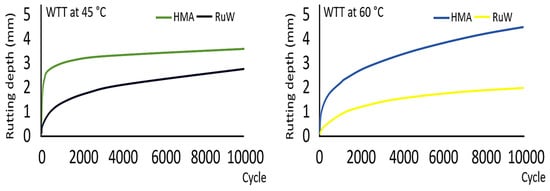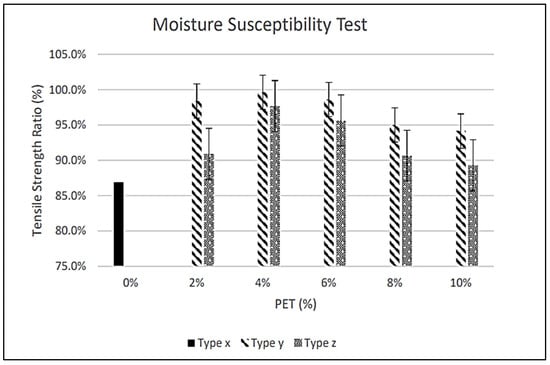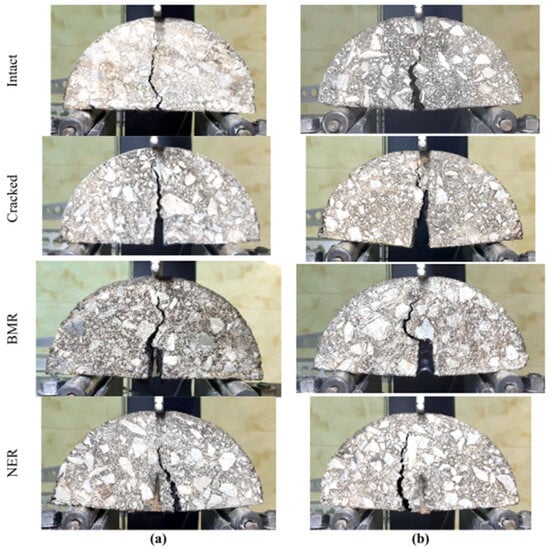You're using an outdated browser. Please upgrade to a modern browser for the best experience.
Please note this is a comparison between Version 2 by Jason Zhu and Version 1 by Zahraa Jwaida.
Asphalt is widely employed in road construction due to its durability and ability to withstand heavy traffic. However, the disposal of waste polymers has emerged as a significant environmental concern. Recently, researchers have used polymer waste to modify asphalt pavements as a new approach. This approach aims to improve pavement performance and address the environmental concerns of polymer waste. Researchers have demonstrated that incorporating polymeric waste into asphalt mixtures can lead to performance improvements in asphalt pavements, particularly in mitigating common distresses including permanent deformation and thermal and fatigue cracking.
- asphalt mixtures
- aging
- sustainability
- moisture damage
- waste polymers
1. Introduction
An effective measure to enhance the performance of long-life pavements includes letting the materials of pavement acquire self-healing characteristics [1,2][1][2]. With a crack’s formation in asphalt, the pavement’s asphalt mixture possesses self-healing properties, allowing it to repair cracks autonomously and thereby prolonging the service life of the pavement [3,4,5][3][4][5].
Worldwide, a significant quantity of waste materials are produced, leading to adverse environmental effects such as soil, air, and water pollution. These environmental challenges have implications for economic considerations, human health, and energy conservation. Moreover, the accumulation of waste materials raises concerns regarding the occupation of extensive areas. Consequently, additional investigations have been carried out on the potential reuse of waste materials within the pavement industry [3,4,6][3][4][6].
Plastic materials, i.e., polymers, have become extremely prevalent in daily lives and are utilized in various industries. They serve as essential raw materials for producing a wide range of items, including plastic cups, bottles, housewares, storage containers, and pipes [7]. However, the disposal of these products presents significant environmental challenges. The accumulation of plastic waste in landfills and oceans has generated growing interest in the recycling and reuse of plastics [8]. Plastics have emerged as an essential commodity in contemporary society, and their global production has been consistently growing at a rate of 10% per year since 1950 [9]. Globally in 2021, it was reported that about 390.7 million metric tons of plastic waste were produced, increasing annually by 4% [10]. This significant volume raises concerns about their reuse and recycling safety, primarily due to the potential toxicity of plastic particles and their potential entry into the food chain. Regrettably, the current rates of plastic recycling remain disappointingly low [1,2][1][2]. One way to reduce the issue of polymer waste is by incorporating plastics into construction, specifically in road applications. By integrating reclaimed polymers, this approach reduces plastic waste in landfills while enhancing the mechanical properties of asphalt binders. While using new polymers for asphalt modification can be costly in road construction, waste plastics offer a cost-effective alternative. The utilization of waste plastics to modify asphalt originated in the 1990s, primarily in the form of fibers [11,12,13][11][12][13]. Consequently, it represents an effective technique to improve the performance of asphalt [14,15][14][15].
While it has long been understood that virgin polymers can enhance the characteristics of modified bitumen, using recycled polymers in place of virgin ones raises some questions. The quantity of polymers utilized to repair road surfaces must be minimal because polymers are quite expensive. When it comes to enhancing road performance, recycled plastics have been demonstrated to produce comparable outcomes to virgin polymers. From an economic and environmental standpoint, employing waste polymer as a modifier is advantageous because it might assist in increasing the efficiency of pavement and the quality of roads, as well as find a solution to the problem of waste disposal [16,17][16][17].
There are two primary categories of waste polymers used to modify asphalt binders: thermoplastic elastomers, such as styrene–butadiene–styrene block (SBS) and styrene-butadiene rubber (SBR), and plastomers, including polyethylene (PE) and ethylene–vinyl acetate (EVA). Thermoplastic elastomers impart favorable elastic properties to modified asphalt, whereas plastomers enhance stiffness and reduce deformation under loads [18]. In the asphalt industry, certain plastomers serve as an alternative to thermoplastic elastomers for road paving applications. These polymers exhibit the characteristics of hardening upon cooling and softening upon heating, as thermoplastic materials do. A two-phase morphological structure is produced when polymers, whether plastomeric or elastomeric, are added. Depending on whether the polymer is spread within the asphalt matrix or the asphalt is dispersed within the polymer matrix, this structure may appear as an asphalt-rich phase or a polymer-rich phase [19]. Currently, the most used polymer wastes for modifying asphalt are polyethylene terephthalate (PET), polypropylene (PP), styrene-butadiene rubber (SBR), styrene-butadiene-styrene (SBS), polyethylene (PE), and ethylene-vinyl acetate (EVA) [14,20,21,22][14][20][21][22]. Among plastic types, PE decomposes at a slow rate and persists in the environment for an extended period after disposal [23]. Due to its extensive usage, there has been a notable increase in the amount of polyethylene waste requiring recycling [24]. Recently, there has been increasing interest in reactive polymers for asphalt binder modification. Polyethylene, including linear low-density polyethylene (LLDPE), low-density polyethylene (LDPE), and high-density polyethylene (HDPE), have been extensively researched and used in road applications due to their cost-effectiveness and performance enhancements [20,21,25][20][21][25].
The polymer modification of bitumen has been the subject of several review papers. The interactions between organic–inorganic composites were extensively reviewed by [26], together with their impact on the functionality of cement asphalt emulsion mixtures, while [27] thoroughly examined the wet and dry procedures used to remove different forms of waste plastic from asphalt surfaces. Some of the review papers concentrated on the impact of mixing conditions and the consequent modified bitumen properties, whereas others concentrated on elastomers in the road sector [28].
2. Polymer Modification
2.1. PTP- and PET-Modified Asphalt
The selection of modifiers for any project involves considering various factors, including performance, cost, availability, and feasibility [44][29]. Previous research has examined the impact of waste plastic on asphalt pavement. Abdullah et al. [60][30] found that the optimal content of waste polymers is 8% to provide the highest performance. Kader [61][31] studied the volumetric and stability characteristics of asphalt mixtures incorporating waste plastic. The author found a better volumetric characteristic in the controlled mixture than plastic mixes, though the addition of an extra 4% waste plastic showed improved stability compared with the controlled specimen. Polytrimethylene terephthalate (PTP) is widely applied in the production of liquid and food containers [36][32]. El-Naga and Ragab [57][33] revealed that the inclusion of a PTP modifier improved the softening point, penetration, and strength of the modified asphalt. Figure 21 depicts the relationship between Marshall stiffness and the percentage of PTP in the investigated mixtures. The increase in the PTP content increased the Marshall stiffness values up to 12% PTP content. However, beyond that threshold, these values started to decline, which could be attributed to the increased void content resulting from higher PTP percentages. Ultimately, the quantified benefits demonstrated that incorporating 12% PTP resulted in an increase of 2.81 times in pavement service life and led to approximately 20% savings in the thickness of the asphalt layer. Thus, the optimum content of PTP was found to be 12%.
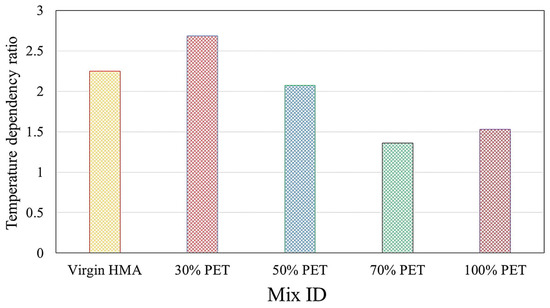
2.2. PE-Modified Asphalt
Polyethylene is widely acknowledged for its non-toxicity, exceptional electrical and chemical resistance, and lightweight characteristics. Moreover, polypropylene resists alkalis and acids, has excellent dielectric properties, and high tensile and compressive strength. However, considering their significant consumption and production, it becomes crucial to emphasize the collection, handling, and proper disposal of these materials [72][45]. Polyethylene is available in various types, including linear low-density polyethylene (LLDPE), low-density polyethylene (LDPE), and high-density polyethylene (HDPE). The structural characteristics of PE, such as melt-flow index (MFI), crystallinity, and density, offer valuable information about its molecular architecture. Figure 43 provides schematic representations of the molecular structure of different types of polyethylene [73][46].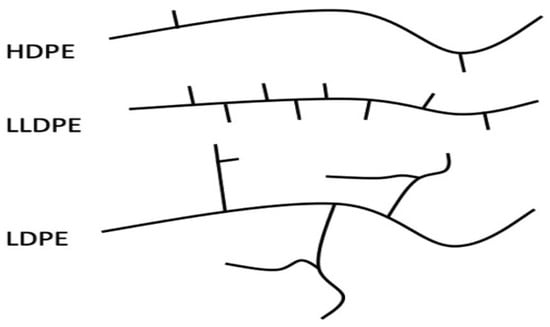
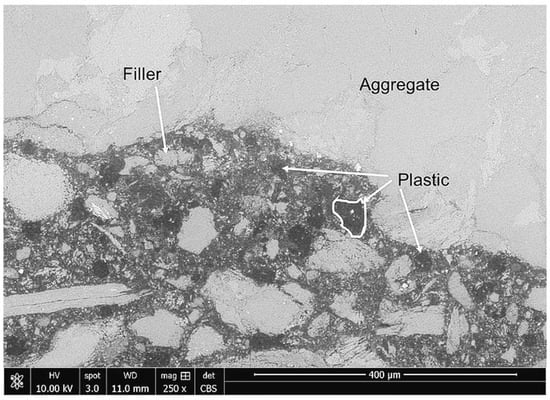
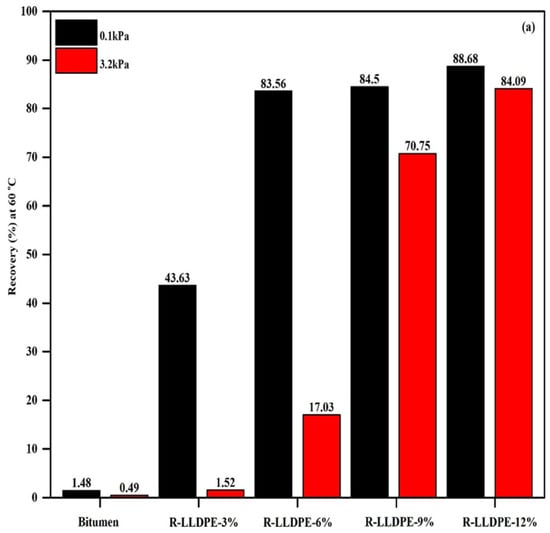

Figure 65.
Recovery rate (
a
) and Jnr results (
2.3. PU-Modified Asphalt
Polyurethane (PU) has been investigated by researchers and pavement engineers because of its remarkable performance [79][54]. The molecular structure of PU includes carbamate groups, which are commonly created when isocyanates and polyols combine. Because it is an organic polymer, PU excels in engineering properties due to its high levels of elongation, energy absorption, chemical and corrosion resistance, thermal stability, cost-effectiveness, diversity in applications and products, and usability [80,81][55][56]. When compared with other polymer-modified asphalts, the preparation of asphalt binders and mixtures with PU modification is very different. Conventional polymer modifiers are often injected directly and blended at high temperatures, mostly through physical reactions. Instead of employing the final PU products, the chain extenders and PU prepolymers are individually added to the asphalt in the case of PU modification. In order to achieve chemical modification, this method seeks to enhance chemical interactions between the highly reactive PU and asphalt components. Furthermore, it is advised to use a high-shear force mixer for the mixing operation, such as a disk-based serrated mixer. The suggested dosage varies from 5% to 15% by weight of the basic binder, with the optimum curing temperature being 175 °C and lasting around an hour [82][57]. PU works as a chemically reactive modifier and shows enhanced compatibility in the asphalt matrix, effectively reducing the risk of phase separation. As a result of these performance improvements, there is growing interest in studying the underlying mechanisms of this modification.2.4. SBS-, SBR-, and EVA-Modified Asphalt
Yeganeh et al. [59][58] explored the possibility of using polybutadiene rubber (PBR) and styrene-butadiene rubber (SBR) as modifiers for bitumen. The results indicate that both polymers showed distinct influences on the anticipated performance and rheology of the modified mixtures. However, SBR provided superior fatigue resistance, even though both polymers exhibited a comparable resistance to permanent deformation. Also, minimal variations were observed between the effects of waste polymers and premium-quality polymers. The primary objective by Gupta et al. [86][59] was to create a novel type of bitumen suitable for porous asphalt (PA) mixtures by incorporating a high-vinyl content SBS polymer that meets PA mixture requirements. The results revealed that a 4.5% polymer content exhibited superior elasticity, enhanced fatigue resistance, and enhanced rutting resistance in comparison with the reference PMB (polymer-modified bitumen). PA-modified mixtures demonstrated increased resistance to abrasion; however, they also experienced higher binder drainage. To address this issue, glass hybrid fibers and aramid pulp were incorporated. Ameri et al. [65][38] examined the fatigue resistance of Hot Mix Asphalt (HMA) modified with PBR and SBR. The traditional method, which relies on a 50% reduction in initial stiffness, was found to be inadequate for determining fatigue life in polymer-modified mixtures. It underestimated the fatigue life and led to significant variations in responses. Thus, the authors conducted alternative techniques, including Energy Ratio and Dissipated Energy Change Ratio methods. Both approaches resulted in a more comprehensive fatigue comparison for tested mixtures. The results revealed a substantial improvement in the fatigue life of polymer-modified mixtures in comparison with virgin asphalt. Costa et al. [75][49] conducted a study to evaluate the use of granulated recycled EVA (EVA(R)gr) and recycled HDPE powder (HDPE(R)p) to modify conventional bitumen. Also, SBS powder (SBS(V)p) was used for comparison purposes. Figure 76 displays the penetration test results. As expected, the use of polymers (virgin SBS, EVA, and recycled HDPE) improved the softening point of the base bitumen. Also, the inclusion of polymers reduced the penetration results, with HDPE having the greatest impact on reducing the penetration value. This reduction resulted from the higher stiffness of the polymers. Thus, from these results, it was expected that the SBS polymer would provide superior fatigue cracking resistance, while the HDPE is likely to provide the highest modulus of stiffness. Moreover, the homogeneity of EVA demonstrated slightly better storage stability than other polymers. Whereas HDPE showed enhanced resistance against rutting, it had the lowest creep recovery and resilience.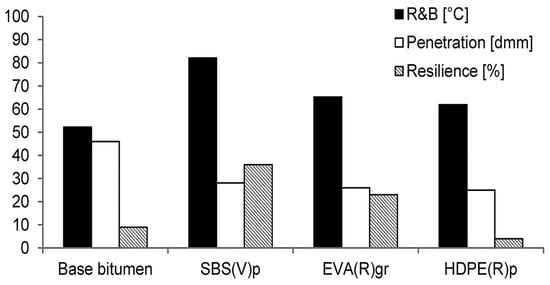
2.5. PVC-Modified Asphalt
Polyvinyl chloride (PVC) is frequently utilized while creating window frames, garden hoses, profiles, and insulating cables. PVC has received the moniker “poison plastic” due to the numerous hazardous compounds that it contains. Dioxins are produced when PVC-based goods are burned or cremated. PVC can emit a sizable amount of hydrochloric acid (HCl) when exposed to high temperatures, even when not burned. Given its poisonous nature, this HCl discharge poses a major risk to both the environment and equipment. There are recommendations to chemically lower chlorine levels in PVC in order to minimize the excessive chlorine content. Chlorine may reportedly be removed from PVC surfaces using nucleophilic substitution techniques that involve amines and hydroxy compounds [87][60]. PVC’s high melting point, which is roughly 298 °C, has complicated several research efforts that have looked into using it as a modifier for bitumen [88,89][61][62]. With varying degrees of effectiveness, other studies [90][63] have sought to modify bitumen using PVC from a variety of sources, such as window frames, cables, and pipelines, or without identifying the origin of the PVC. PVC was discovered to improve the conventional and rheological characteristics of bitumen despite being used as a filler to make PVC-based bituminous mastics. After adding PVC to the base bitumen, the penetration value generally fell, while the softening point value dramatically rose [91][64]. When 5% PVC was added to bitumen, the viscosity increased by up to 300%, but the ductility reduced. The storage stability of PVC-modified bitumen was reported to be improved, notably at 5% PVC, by Fang et al. [92][65], who utilized 0.05%, 0.15%, and 0.25% organic montmorillonite as an agent to enhance its characteristics. The impact of PVC on bitumen (2.5, 5, 7.5, 10, 12, 15, and 20% by the weight of bitumen) was studied by Ramesh and Tech [93][66]. The findings indicate that, from the standpoint of stiffness and stability requirements, utilizing up to 7.5% waste PVC as a modifier can be employed for flexible pavement construction in a warmer climate. Also, waste PVC was employed by Arabani and Yousefpour [94][67] as an additive to improve the functionality of a bitumen and HMA mixture and lessen the rutting value. Ultimately, the outcomes demonstrated that waste PVC particles could improve the rheological characteristics of bitumen and raise the resistance of HMA samples to rutting degeneration. Salman and colleagues [95][68] conducted an assessment of the physical characteristics of bitumen (40–50) when blended with varying percentages (2.5%, 5%, 7.5%, 10%, 12%, and 15%) of waste PVC. The findings revealed that as the PVC modifier content increased, the penetration rate decreased by 62.8%. Similarly, an increase in PVC content led to a reduction in ductility, while the softening point showed an upward trend with higher PVC percentages. The effects of waste PVC and Electric Arc Furnace Dust (EAFD) on the chemical, physical, and mechanical properties of bitumen and asphalt mixtures were investigated by Ziari et al. [96][69]. The outcome showed that these modifiers improved the asphalt mixtures’ deformation resistance, moisture susceptibility, and tensile strength. Ezzat and Abed [97][70] concluded that bitumen modified with PVC and SBS had a more favorable effect on the aging process than pure bitumen based on the results of FTIR tests.2.6. CSR-Modified Asphalt
The use of PB (polybutadiene) as a core with CSR (core–shell rubber) particles was investigated to enhance the toughness of a hot-mix epoxy asphalt binder (HEAB). These CSR particles were incorporated into epoxy oligomers along with the base asphalt and curing agent of a HEAB [98][71]. The inclusion of CSR improved the thermal stability and glass transition temperature of the HEAB. Even with just 1 wt% of CSR, the toughness, elongation, and tensile strength increased by 200%, 60%, and 29%, respectively. Nevertheless, the use of 3 wt% of CSR resulted in an alteration of the phase separation mechanism. Su et al. [58][72] focused on the preparation of CSR-modified HEABs by incorporating 2 wt% CSR with various core polymers. The results indicate that CSR-modified HEABs with an SBS core (CSRSB) exhibit higher viscosity during the curing process compared with CSR-modified HEABs with a PB core (CSRPB). The destruction of the CSR particle shell caused the core polymers to swell, leading to the dispersion of asphalt and polymer particles in the epoxy phase at the micron scale. In CSRPB-modified HEABs, phase separation occurred through spinodal decomposition, which differs from the growth and nucleation mechanism observed in CSRSB and HEAB. The thermal stability of CSR-modified HEABs was minimally affected by the core polymer. Using CSR particles enhanced the mechanical properties of HEAB and the glass transition temperatures of the epoxy and asphalt. In comparison, CSRPB demonstrated higher toughness and tensile strength than CSRSB. The use of 2 wt% CSRPB increased toughness, elongation, and tensile strength by 110%, 42%, and 53, respectively.3. Hybrid Modification
Recent research has indicated that the hybrid modification of asphalt binders, which involves incorporating multiple modifiers, can yield significant improvements in their rheological properties [99,100][73][74]. While the inclusion of waste polyethylene (PE) has shown positive effects on the high-temperature characteristics and rutting resistance of asphalt binders, it negatively affects their low-temperature characteristics. To address this limitation, researchers suggest combining waste PE with elastomers such as SBS and CR [46][75]. CR has widely been used in particle sizes in a range between 0.075 mm and 4.75 mm, as well as a content between 5 wt.% and 20 wt.% [101,102][76][77]. The inclusion of CR in asphalt binders enhances their moisture damage and cracking due to temperature, fatigue, or rutting [103][78]. For instance, a composite modifier consisting of recycled HDPE, crumbed rubber (CR), and bitumen has demonstrated enhanced fatigue life at low strain levels, high-temperature behavior, and rutting resistance [104][79]. However, it may adversely affect the fatigue life of the binder under high-shear strain conditions. Other studies have explored the modification of recycled PE and waste tire rubber, resulting in enhanced high-temperature behavior with enhanced rutting resistance, increased softening point, and reduced penetration while maintaining unchanged low-temperature performance [100][74]. Also, studies have revealed that the use of CR in the base binder improves its fatigue and rutting durability. This addition also leads to reduced costs for mixture rehabilitation and maintenance, enhances pavement longevity, and contributes to decreased traffic noise levels [105,106][80][81]. Duarte and Faxina [14] investigated the impacts of using CR and LDPE on the rheological characteristics of modified asphalt at high temperatures. Both modifications had a positive impact on performance grade through increasing the Superpave parameter and the storage stability of asphalt. Moreover, the results indicated that the composite modification effectively enhanced the performance of asphalt at high temperatures. Using CR and LDPE as a hybrid modification strategy demonstrated significant potential in promoting sustainability within the paving industry. Ameli et al. [3] evaluated the impact of PET, ground tire rubber (GTR), and antistripping agents (ASA) on the behavior of stone matrix asphalt (SMA) mixtures. They revealed that the incorporation of these polymers enhanced the elasticity of the binders, resulting in enhanced permanent deformation resistance. Moreover, the addition of PET contributed to improved resistance against rutting. The findings indicated that using PET, GTR, and ASA composites significantly enhanced the resilient modulus, fatigue life, rutting resistance, indirect tensile strength, and fracture energy of the modified asphalt. According to the results, it was observed that modifying the binder using a 50%PET/50%GTR ratio and ASA type (B) indicated superior resistance against fatigue cracking. Luo et al. [107][82] investigated a novel approach to incorporating waste oil into polymer-modified asphalt binders and evaluated the impact on various characteristics. Experimental findings revealed that the use of polymers with waste oil provided a significant enhancement in the anti-aging and high-temperature characteristics, improved recovery, and reduced deformation of asphalt. Figure 87 illustrates the impact of polymers and waste oil on the storage stability of the modified asphalt. The findings suggested that waste oil has minimal impact on storage stability, making it suitable for pavement use even after prolonged storage at high temperatures. The reason was due to the existence of unsaturated fatty acids in waste oil, which enhance the compatibility of the modified asphalt. Consequently, the waste oil allowed the polymers to swell sufficiently and access the spaces between polymer chains, thereby increasing the distance between polymer segments and facilitating molecular movement. This led to the uniform dispersion of polymers within the mixture and improved the compatibility between the polymers and asphalt.
4. Moisture Susceptibility
Moisture represents a key parameter impacting the performance of asphalt pavements. While it does not directly cause rutting, fatigue cracking, or permanent deformation, it intensifies its severity. In the past, moisture damage has been attributed to six mechanisms: displacement, pore pressure, spontaneous emulsification, hydraulic scouring, detachment, and the environmental impact on asphalt mixtures. It is important to note that no one mechanism is responsible for moisture damage, but rather a combination of processes [29][88]. Aggregate and asphalt binders are the main components of asphalt mixtures, and their chemical and physical characteristics directly impact the susceptibility to moisture damage [113][89]. There are two main ways in which water affects asphalt pavement. The first interaction is with the asphalt binder, which loses some of its cohesive strength and makes the asphalt mixture less firm. Secondly, water escapes into the spaces between the asphalt binder film and aggregates, causing the adhesive to fail and ultimately separating the aggregates from the binder film. Adhesion, an essential characteristic of asphalt mixtures, significantly impacts the quality and durability of the pavement. The response of the system involves a decrease in the load-carrying capacity due to internal structural changes [114][90]. Moisture can enter asphalt pavements through aggregate absorption, rainwater, and rising groundwater levels. This water infiltration increases the cost of maintenance and reduces the design life of the asphalt pavement [113][89]. Haider et al. [29][88] aimed to enhance the resistance to moisture damage by incorporating waste plastic modifiers. Based on rock petrography, four distinct aggregate sources were chosen to investigate the impacts of various minerals on moisture degradation. Testing was conducted both qualitatively and quantitatively to determine moisture sensitivity. The wet technique of mixing and HDPE showed comparatively stronger adhesion qualities, according to the analysis of the test results. In comparison with LDPE, HDPE demonstrated greater resistance to moisture sensitivity across all aggregate quarries. Moreover, aggregates with acidic characteristics, containing granite minerals, showed greater adhesion loss in comparison with basic aggregate quarries because of their hydrophilic nature and lower polarity. Except for the rolling bottle test, all modifiers and aggregate quarries showed a lower than 20% loss based on the minimal failure criteria of 20% imposed. When assessing moisture damage in compacted asphalt mixtures, it was discovered that the Modified Lottman and Hamburg wheel track tests were more useful than the Marshall stability test. Furthermore, the addition of nitrogen-based compounds, such as anti-strip additives, to bitumen has been discovered to enhance the long-term durability of conventional Hot Mix Asphalt (HMA) against moisture damage. These additives create electron shear/hydrogen bonds with hydrophobic siliceous aggregates, thereby contributing to moisture resistance [115][91]. Karmakar and Kumar Roy [116][92] evaluated the moisture damage of HMA by incorporating various fractions of waste plastic. The results of the study indicated that incorporating 1% of different waste plastic fractions, specifically 2 parts of polybutene (PB), 0.25 parts of polymethylpentene (PMP), and 1 part of polycarbonate (PC), into HMA using a wet process yielded the highest resistance to moisture damage. The improved resistance was because of the presence of robust nitrogenous chemical fractions. Consequently, this combination of waste plastic fractions may serve as an effective modifier for bitumen, enhancing moisture resistance and ensuring the durability of bituminous mixes. Agha et al. [54][93] investigated the performance of PET-modified HMA. The findings indicate that the dry mixing provided better flow, stability, and fatigue cracking resistance, while the wet mixing provided better moisture damage resistance. However, incorporating more than 4% PET reduced flow, stability, and fatigue cracking resistance as a result of the stiff nature of PET. Figure 109 illustrates the tensile strength ratios of the modified binders with different PET contents. The results support the hypothesis that increasing the PET content enhances the pavement’s resistance to moisture damage, as evidenced by the improved TSR (%). The TSR improvement was gradual from 0% to 4% PET content. However, beyond a 4% PET content, the pavement’s resistance to moisture damage began to decline. Notably, wet mixing outperforms dry mixing in terms of moisture susceptibility for each PET content. The optimal PET content for the moisture susceptibility test is found to be 4%. Molecular dynamics (MD) simulation can be used for assessing the density and adhesion between binders and aggregates. Li et al. [117][94] developed a recycling method that utilizes waste PET as an anti-stripping agent in asphalt mixtures. An amine-based PET additive made from waste PET is produced via an aminolysis reaction and is used to alter the bitumen. The additive made from waste PET effectively improves the moisture damage resistance, according to both experimental findings and MD simulations. Zachariah et al. [118][95] focused on investigating the rutting and moisture damage resistance in bituminous concrete reinforced with polypropylene fibers by using crushed brick waste as an aggregate. The effectiveness of crushed brick waste and polymer wastes was investigated using seven distinct mixtures under wet and dry mixing methods. In comparison to the control samples made with natural stone aggregate, the modified bituminous samples showed equivalent moisture susceptibility and rutting resistance. The results showed that, at 25 °C, all mixtures, except the ones with unreinforced brick aggregate, exhibited satisfactory moisture susceptibility and rutting resistance. Only the mixture with 1% dry mixed polypropylene fibers and overburnt brick aggregate, however, performed satisfactorily in terms of rutting and moisture susceptibility at 50 °C. Additionally, the susceptibility index (MSI) was identified as a more reliable indicator for assessing moisture susceptibility compared with the stripping inflection point (SIP).5. Aging, Rejuvenation, RAP
Asphalt mixtures are extensively utilized in road construction, offering long-lasting service life when appropriately designed and maintained. However, pavements, like any structure, are prone to various types of damage, with cracking being a common mode of failure. Cracks can develop due to factors such as heavy traffic loads, freeze–thaw cycles, wear, and fatigue. In addition to affecting performance, cracking can lead to more severe damage to pavement systems. When top-down cracks occur and allow water to infiltrate the underlying layers, it can cause damage, resulting in higher road repair and maintenance costs [119,120][96][97]. From a crack propagation perspective, as illustrated in Figure 110, two common types of cracks in pavements are categorized as top-down and bottom-up cracks. Top-down cracks arise from both shear and tensile stresses, while bottom-up cracking typically occurs due to bending-induced stress. Repairing top-down cracks is relatively more feasible, whereas the repair of bottom-up cracks is challenging due to limited accessibility [121,122][98][99].
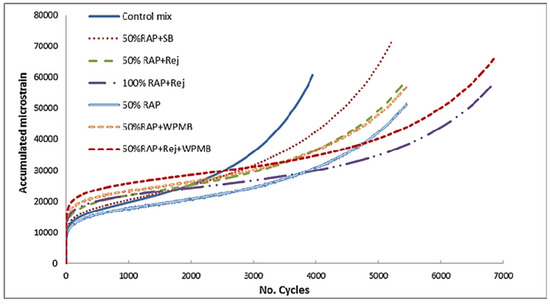
6. Benefits and Drawbacks
To assess the performance of changed samples made utilizing both dry and wet procedures, numerous investigations were carried out. These investigations show that the wet procedure improves the rheological qualities, rutting resistance, and temperature susceptibility of the original bitumen. Over 94% of the examined publications reported that modified asphalt mixtures were less susceptible to high temperatures than the original bitumen, according to Vargas and Hanandeh’s thorough literature assessment [136][114]. According to Padhan et al. [137][115], the addition of waste plastics during the wet process increased the adhesive force at the bitumen–aggregate interface. Karmakar and Roy [116][92] observed that the adhesive capability of WPMAM was approximately doubled compared with virgin bitumen, which also corroborated this conclusion. Although the wet method is addressed in the literature as having some advantages, there are also problems and conflicts that have been found. The wet process is time- and energy-intensive, requiring specialized mixing machinery. Additionally, only a small fraction of the bitumen, which makes up about 5% of the total weight of the asphalt mixture, is replaced by plastic throughout this process, resulting in a negligible quantity of plastic waste [138][116]. The wet process faces additional difficulties with storage stability since modified bitumen maintained at high temperatures requires stirring to preserve its homogeneity [139][117]. Additionally, the wet process may make some virgin bitumen properties worse, like the susceptibility to cold cracking [64][36]. The outcomes that have been reported in the literature have some discrepancies. For example, Padhan et al. [59][58] and Fethiza et al. [140][118] observed that the treatment of waste plastic using the wet technique delays bitumen binder aging and enhances the mixture’s early fatigue behavior. Similar to the wet process, the dry method offers benefits and drawbacks. With only modest adjustments, the dry process may use a wider range of plastic types than the wet technique. Additionally, it is easier and does not call for specialized tools [141][119]. According to research, changing waste plastics during the dry process can enhance the mixture’s stiffness modulus, fatigue behavior, resistance to rutting, susceptibility to moisture, and susceptibility to changes in temperature [142,143][120][121]. These enhancements take place as a result of the polymers’ ability to coat aggregate surfaces, strengthen the binding between the aggregate and binder, or alter bitumen while it is being mixed. The findings of several studies are not all consistent, though, as some have noted the negative impacts of the dry method on these factors. Problems with the dry process have been attributed to insufficient interaction between the binder and plastics as a result of the inadequate assimilation of plastics into the bitumen owing to the brief mixing period [144][122]. Additionally, it has been noted that the asphalt mixture’s loss of cohesiveness causes it to be more sensitive to moisture. Various factors, such as variations in mixing order, mixing temperature, and plastic particle size and shape, may be responsible for these contradictory results [145][123].References
- He, P.; Chen, L.; Shao, L.; Zhang, H.; Lü, F. Municipal Solid Waste (MSW) Landfill: A Source of Microplastics? Evidence of Microplastics in Landfill Leachate. Water Res. 2019, 159, 38–45.
- Hwang, J.; Choi, D.; Han, S.; Choi, J.; Hong, J. An Assessment of the Toxicity of Polypropylene Microplastics in Human Derived Cells. Sci. Total Environ. 2019, 684, 657–669.
- Ameli, A.; Maher, J.; Mosavi, A.; Nabipour, N.; Babagoli, R.; Norouzi, N. Performance Evaluation of Binders and Stone Matrix Asphalt (SMA) Mixtures Modified by Ground Tire Rubber (GTR), Waste Polyethylene Terephthalate (PET) and Anti Stripping Agents (ASAs). Constr. Build. Mater. 2020, 251, 118932.
- Rezvan, B.; Hassan, Z. Evaluation of Rutting Performance of Stone Matrix Asphalt Mixtures Containing Warm Mix Additives. J. Cent. South. Univ. 2017, 24, 360–373.
- Lu, D.; Jiang, X.; Leng, Z.; Zhang, S.; Wang, D.; Zhong, J. Dual Responsive Microwave Heating-Healing System in Asphalt Concrete Incorporating Coal Gangue and Functional Aggregate. J. Clean. Prod. 2023, 422, 138648.
- Yaro, N.S.A.; Sutanto, M.H.; Habib, N.Z.; Napiah, M.; Usman, A.; Jagaba, A.H.; Al-Sabaeei, A.M. Modeling and Optimization of Asphalt Content, Waste Palm Oil Clinker Powder and Waste Rice Straw Ash for Sustainable Asphalt Paving Employing Response Surface Methodology: A Pilot Study. Clean. Mater. 2023, 8, 100187.
- Dwivedi, P.; Mishra, P.K.; Mondal, M.K.; Srivastava, N. Non-Biodegradable Polymeric Waste Pyrolysis for Energy Recovery. Heliyon 2019, 5, e02198.
- Behnood, A.; Modiri Gharehveran, M. Morphology, Rheology, and Physical Properties of Polymer-Modified Asphalt Binders. Eur. Polym. J. 2019, 112, 766–791.
- Shen, M.; Huang, W.; Chen, M.; Song, B.; Zeng, G.; Zhang, Y. (Micro)Plastic Crisis: Un-Ignorable Contribution to Global Greenhouse Gas Emissions and Climate Change. J. Clean. Prod. 2020, 254, 120138.
- Statista. Annual Production of Plastics Worldwide from 1950 to 2021 (in Million Metric Tons). Available online: https://www.statista.com/statistics/282732/global-production-of-plastics-since-1950/ (accessed on 1 April 2023).
- Martin-Alfonso, J.E.; Cuadri, A.A.; Torres, J.; Hidalgo, M.E.; Partal, P. Use of Plastic Wastes from Greenhouse in Asphalt Mixes Manufactured by Dry Process. Road Mater. Pavement Des. 2019, 20, S265–S281.
- Heydari, S.; Hajimohammadi, A.; Haji Seyed Javadi, N.; Khalili, N. The Use of Plastic Waste in Asphalt: A Critical Review on Asphalt Mix Design and Marshall Properties. Constr. Build. Mater. 2021, 309, 125185.
- Kakar, M.R.; Mikhailenko, P.; Piao, Z.; Bueno, M.; Poulikakos, L. Analysis of Waste Polyethylene (PE) and Its by-Products in Asphalt Binder. Constr. Build. Mater. 2021, 280, 122492.
- Duarte, G.M.; Faxina, A.L. High-Temperature Rheological Properties of Asphalt Binders Modified with Recycled Low-Density Polyethylene and Crumb Rubber. Constr. Build. Mater. 2021, 298, 123852.
- tur Rasool, R.; Wang, S.; Zhang, Y.; Li, Y.; Zhang, G. Improving the Aging Resistance of SBS Modified Asphalt with the Addition of Highly Reclaimed Rubber. Constr. Build. Mater. 2017, 145, 126–134.
- Kalantar, Z.N.; Karim, M.R.; Mahrez, A. A Review of Using Waste and Virgin Polymer in Pavement. Constr. Build. Mater. 2012, 33, 55–62.
- Anwar, M.K.; Shah, S.A.R.; Alhazmi, H. Recycling and Utilization of Polymers for Road Construction Projects: An Application of the Circular Economy Concept. Polymers 2021, 13, 1330.
- Zhu, J.; Birgisson, B.; Kringos, N. Polymer Modification of Bitumen: Advances and Challenges. Eur. Polym. J. 2014, 54, 18–38.
- Hunter, R.N.; Self, A.; Read, J. The Shell Bitumen Handbook, 6th ed.; ICE Publishing: London, UK, 2015.
- Du, Z.; Jiang, C.; Yuan, J.; Xiao, F.; Wang, J. Low Temperature Performance Characteristics of Polyethylene Modified Asphalts—A Review. Constr. Build. Mater. 2020, 264, 120704.
- Leng, Z.; Padhan, R.K.; Sreeram, A. Production of a Sustainable Paving Material through Chemical Recycling of Waste PET into Crumb Rubber Modified Asphalt. J. Clean. Prod. 2018, 180, 682–688.
- Mustafa, S.; Hameed, M.A.; Dulaimi, A. Evaluation of the Properties of Modified Local Asphalt Binder by Using Styrene Butadiene Rubber (SBR) or Low-Density Polyethylene (LDPE). Sci. Rev. Eng. Environ. Sci. 2022, 31, 190–202.
- Padhan, R.K.; Sreeram, A. Enhancement of Storage Stability and Rheological Properties of Polyethylene (PE) Modified Asphalt Using Cross Linking and Reactive Polymer Based Additives. Constr. Build. Mater. 2018, 188, 772–780.
- Delva, L.; Hubo, S.; Cardon, L.; Ragaert, K. On the Role of Flame Retardants in Mechanical Recycling of Solid Plastic Waste. Waste Manag. 2018, 82, 198–206.
- Abduljabbar, N.; Al-Busaltan, S.; Dulaimi, A.; Al-Yasari, R.; Sadique, M.; Nageim, H. Al the Effect of Waste Low-Density Polyethylene on the Mechanical Properties of Thin Asphalt Overlay. Constr. Build. Mater. 2022, 315, 125722.
- Lu, D.; Jiang, X.; Tan, Z.; Yin, B.; Leng, Z.; Zhong, J. Enhancing Sustainability in Pavement Engineering: A-State-of-the-Art Review of Cement Asphalt Emulsion Mixtures. Clean. Mater. 2023, 9, 100204.
- Ma, Y.; Zhou, H.; Jiang, X.; Polaczyk, P.; Xiao, R.; Zhang, M.; Huang, B. The Utilization of Waste Plastics in Asphalt Pavements: A Review. Clean. Mater. 2021, 2, 100031.
- Nizamuddin, S.; Boom, Y.J.; Giustozzi, F. Sustainable Polymers from Recycled Waste Plastics and Their Virgin Counterparts as Bitumen Modifiers: A Comprehensive Review. Polymers 2021, 13, 3242.
- Appiah, J.K.; Berko-Boateng, V.N.; Tagbor, T.A. Use of Waste Plastic Materials for Road Construction in Ghana. Case Stud. Constr. Mater. 2017, 6, 1–7.
- Abdullah, M.E.; Abd Kader, S.A.; Jaya, R.P.; Yaacob, H.; Hassan, N.A.; Wan, C.N.C. Effect of Waste Plastic as Bitumen Modified in Asphalt Mixture. In Proceedings of the MATEC Web of Conferences; EDP Sciences: Les Ulis, France, 2017; Volume 103, p. 09018.
- Abd Kader, S.A.; Jaya, R.P.; Yaacob, H.; Hainin, M.R.; Hassan, N.A.; Ibrahim, M.H.W.; Mohamed, A.A. Stability and Volumetric Properties of Asphalt Mixture Containing Waste Plastic. In Proceedings of the MATEC Web of Conferences; EDP Sciences: Les Ulis, France, 2017; Volume 103, p. 09002.
- Sughanthy, S.A.P.; Ansari, M.N.M.; Atiqah, A. Dynamic Mechanical Analysis of Polyethylene Terephthalate/Hydroxyapatite Biocomposites for Tissue Engineering Applications. J. Mater. Res. Technol. 2020, 9, 2350–2356.
- El-Naga, I.A.; Ragab, M. Benefits of Utilization the Recycle Polyethylene Terephthalate Waste Plastic Materials as a Modifier to Asphalt Mixtures. Constr. Build. Mater. 2019, 219, 81–90.
- Tshifularo, C.A.; Patnaik, A. Recycling of Plastics into Textile Raw Materials and Products. In Sustainable Technologies for Fashion and Textiles; Elsevier: Amsterdam, The Netherlands, 2020; pp. 311–326.
- Foti, D. Recycled Waste PET for Sustainable Fiber-Reinforced Concrete. Use of Recycled Plastics in Eco-Efficient Concrete; Elsevier: Amsterdam, The Netherlands, 2019; pp. 387–410.
- Aghayan, I.; Khafajeh, R. Recycling of PET in Asphalt Concrete. Use of Recycled Plastics in Eco-Efficient Concrete; Elsevier: Amsterdam, The Netherlands, 2019; pp. 269–285.
- Taherkhani, H.; Arshadi, M.R. Investigating the Mechanical Properties of Asphalt Concrete Containing Waste Polyethylene Terephthalate. Road Mater. Pavement Des. 2019, 20, 381–398.
- Ameri, M.; Yeganeh, S.; Erfani Valipor, P. Experimental Evaluation of Fatigue Resistance of Asphalt Mixtures Containing Waste Elastomeric Polymers. Constr. Build. Mater. 2019, 198, 638–649.
- Movilla-Quesada, D.; Raposeiras, A.C.; Olavarría, J. Effects of Recycled Polyethylene Terephthalate (PET) on Stiffness of Hot Asphalt Mixtures. Adv. Civil. Eng. 2019, 2019, 6969826.
- Esfandabad, A.S.; Motevalizadeh, S.M.; Sedghi, R.; Ayar, P.; Asgharzadeh, S.M. Fracture and Mechanical Properties of Asphalt Mixtures Containing Granular Polyethylene Terephthalate (PET). Constr. Build. Mater. 2020, 259, 120410.
- Xu, X.; Chen, G.; Wu, Q.; Leng, Z.; Chen, X.; Zhai, Y.; Tu, Y.; Peng, C. Chemical Upcycling of Waste PET into Sustainable Asphalt Pavement Containing Recycled Concrete Aggregates: Insight into Moisture-Induced Damage. Constr. Build. Mater. 2022, 360, 129632.
- Merkel, D.R.; Kuang, W.; Malhotra, D.; Petrossian, G.; Zhong, L.; Simmons, K.L.; Zhang, J.; Cosimbescu, L. Waste PET Chemical Processing to Terephthalic Amides and Their Effect on Asphalt Performance. ACS Sustain. Chem. Eng. 2020, 8, 5615–5625.
- Zhang, H.; Huang, M.; Hong, J.; Lai, F.; Gao, Y. Molecular Dynamics Study on Improvement Effect of Bis(2-Hydroxyethyl) Terephthalate on Adhesive Properties of Asphalt-Aggregate Interface. Fuel 2021, 285, 119175.
- Leng, Z.; Sreeram, A.; Padhan, R.K.; Tan, Z. Value-Added Application of Waste PET Based Additives in Bituminous Mixtures Containing High Percentage of Reclaimed Asphalt Pavement (RAP). J. Clean. Prod. 2018, 196, 615–625.
- Martínez-López, M.; Martínez-Barrera, G.; Salgado-Delgado, R.; Gencel, O. Recycling Polypropylene and Polyethylene Wastes in Production of Polyester Based Polymer Mortars. Constr. Build. Mater. 2021, 274, 121487.
- Ragaert, K.; Delva, L.; Van Damme, N.; Kuzmanovic, M.; Hubo, S.; Cardon, L. Microstructural Foundations of the Strength and Resilience of LLDPE Artificial Turf Yarn. J. Appl. Polym. Sci. 2016, 133, 1–12.
- Teltayev, B.B.; Rossi, C.O.; Izmailova, G.G.; Amirbayev, E.D.; Elshibayev, A.O. Evaluating the Effect of Asphalt Binder Modification on the Low-Temperature Cracking Resistance of Hot Mix Asphalt. Case Stud. Constr. Mater. 2019, 11, e00238.
- Rafiq Kakar, M.; Mikhailenko, P.; Piao, Z.; Poulikakos, L.D. High and Low Temperature Performance of Polyethylene Waste Plastic Modified Low Noise Asphalt Mixtures. Constr. Build. Mater. 2022, 348, 128633.
- Costa, L.M.B.; Silva, H.M.R.D.; Peralta, J.; Oliveira, J.R.M. Using Waste Polymers as a Reliable Alternative for Asphalt Binder Modification—Performance and Morphological Assessment. Constr. Build. Mater. 2019, 198, 237–244.
- Dalhat, M.A.; Al-Abdul Wahhab, H.I. Performance of Recycled Plastic Waste Modified Asphalt Binder in Saudi Arabia. Int. J. Pavement Eng. 2017, 18, 349–357.
- Nizamuddin, S.; Jamal, M.; Gravina, R.; Giustozzi, F. Recycled Plastic as Bitumen Modifier: The Role of Recycled Linear Low-Density Polyethylene in the Modification of Physical, Chemical and Rheological Properties of Bitumen. J. Clean. Prod. 2020, 266, 121988.
- Amirkhanian, S. Utilization of Scrap Plastics in Asphalt Binders. In Eco-Efficient Pavement Construction Materials; Elsevier: Amsterdam, The Netherlands, 2020; pp. 13–32.
- Liang, M.; Xin, X.; Fan, W.; Zhang, J.; Jiang, H.; Yao, Z. Comparison of Rheological Properties and Compatibility of Asphalt Modified with Various Polyethylene. Int. J. Pavement Eng. 2021, 22, 11–20.
- Cong, L.; Yang, F.; Guo, G.; Ren, M.; Shi, J.; Tan, L. The Use of Polyurethane for Asphalt Pavement Engineering Applications: A State-of-the-Art Review. Constr. Build. Mater. 2019, 225, 1012–1025.
- Demirel, S.; Ergun Tuna, B. Evaluation of the Cyclic Fatigue Performance of Polyurethane Foam in Different Density and Category. Polym. Test. 2019, 76, 146–153.
- Boutar, Y.; Naïmi, S.; Mezlini, S.; Carbas, R.J.C.; da Silva, L.F.M.; Ben Sik Ali, M. Fatigue Resistance of an Aluminium One-Component Polyurethane Adhesive Joint for the Automotive Industry: Effect of Surface Roughness and Adhesive Thickness. Int. J. Adhes. Adhes. 2018, 83, 143–152.
- Li, X.; Li, J.; Wang, J.; Yuan, J.; Jiang, F.; Yu, X.; Xiao, F. Recent Applications and Developments of Polyurethane Materials in Pavement Engineering. Constr. Build. Mater. 2021, 304, 124639.
- Yeganeh, S.; Ameri, M.; Dalmazzo, D.; Santagata, E. Experimental Investigation on the Use of Waste Elastomeric Polymers for Bitumen Modification. Appl. Sci. 2020, 10, 2671.
- Gupta, A.; Lastra-Gonzalez, P.; Rodriguez-Hernandez, J.; González González, M.; Castro-Fresno, D. Critical Assessment of New Polymer-Modified Bitumen for Porous Asphalt Mixtures. Constr. Build. Mater. 2021, 307, 124957.
- Padhan, R.K.; Sreeram, A.; Mohanta, C.S. Chemically Recycled Polyvinyl Chloride as a Bitumen Modifier: Synthesis, Characterisation and Performance Evaluation. Road Mater. Pavement Des. 2021, 22, 639–652.
- Al-Abdul Wahhab, H.I.; Dalhat, M.A.; Habib, M.A. Storage Stability and High-Temperature Performance of Asphalt Binder Modified with Recycled Plastic. Road Mater. Pavement Des. 2017, 18, 1117–1134.
- Fakhri, M.; Shahryari, E.; Ahmadi, T. Investigate the use of recycled polyvinyl chloride (PVC) particles in improving the mechanical properties of stone mastic asphalt (SMA). Constr. Build. Mater. 2022, 326, 126780.
- Behl, A.; Sharma, G.; Kumar, G. A Sustainable Approach: Utilization of Waste PVC in Asphalting of Roads. Constr. Build. Mater. 2014, 54, 113–117.
- Chandrasekaran, P.; Nirmalkumar, K.; Uthra, R.; Vihash Kumar, K.S.; Vishnu, R. Study on Construction of Roads Using PVC Wastes-review. IOP Conf. Ser. Mater. Sci. Eng. 2021, 1145, 012105.
- Fang, C.; Liu, X.; Yu, R.; Liu, P.; Lei, W. Preparation and Properties of Asphalt Modified with a Composite Composed of Waste Package Poly(Vinyl Chloride) and Organic Montmorillonite. J. Mater. Sci. Technol. 2014, 30, 1304–1310.
- Ramesh, B.T.; Tech, M. A Study On Effect Of Pvc In The Performance Of The Bituminous Concrete Mix. Int. J. Electr. Comput. Commun. Eng. 2018, 4, 170–179.
- Arabani, M.; Yousefpour Taleghani, M. Rutting Behavior of Hot Mix Asphalt Modified by Polyvinyl Chloride Powder. Pet. Sci. Technol. 2017, 35, 1621–1626.
- Salman, N.; Jaleel, Z. Effects of Waste PVC Addition on the Properties of (40-50) Grade Asphalt. MATEC Web Conf. 2018, 162, 01046.
- Ziari, H.; Nasiri, E.; Amini, A.; Ferdosian, O. The Effect of EAF Dust and Waste PVC on Moisture Sensitivity, Rutting Resistance, and Fatigue Performance of Asphalt Binders and Mixtures. Constr. Build. Mater. 2019, 203, 188–200.
- Ezzat, E.N.; Abed, A.H. Enhancement Rheological Properties of Asphalt Binder Modified with Hybrid Polymers According to Superpave System. Mater. Today Proc. 2020, 20, 572–578.
- Su, W.; Han, X.; Gong, J.; Xi, Z.; Zhang, J.; Wang, Q.; Xie, H. Toughening Epoxy Asphalt Binder Using Core-Shell Rubber Nanoparticles. Constr. Build. Mater. 2020, 258, 119716.
- Su, W.; Zhao, R.; Wang, R.; Xi, Z.; Cai, J.; Zhang, J.; Wang, Q.; Xie, H. Microstructure and Performance of Epoxy Asphalt Binders Modified by Core-Shell Rubbers Containing Different Core Polymers. Constr. Build. Mater. 2021, 304, 124689.
- Brasileiro, L.L.; Moreno-Navarro, F.; Martínez, R.T.; del Sol-Sánchez, M.; Matos, J.M.E.; del Carmen Rubio-Gámez, M. Study of the Feasability of Producing Modified Asphalt Bitumens Using Flakes Made from Recycled Polymers. Constr. Build. Mater. 2019, 208, 269–282.
- Ge, D.; Yan, K.; You, Z.; Xu, H. Modification Mechanism of Asphalt Binder with Waste Tire Rubber and Recycled Polyethylene. Constr. Build. Mater. 2016, 126, 66–76.
- Liang, M.; Xin, X.; Fan, W.; Wang, H.; Jiang, H.; Zhang, J.; Yao, Z. Phase Behavior and Hot Storage Characteristics of Asphalt Modified with Various Polyethylene: Experimental and Numerical Characterizations. Constr. Build. Mater. 2019, 203, 608–620.
- Bressi, S.; Fiorentini, N.; Huang, J.; Losa, M. Crumb Rubber Modifier in Road Asphalt Pavements: State of the Art and Statistics. Coatings 2019, 9, 384.
- Nanjegowda, V.H.; Biligiri, K.P. Recyclability of Rubber in Asphalt Roadway Systems: A Review of Applied Research and Advancement in Technology. Resour. Conserv. Recycl. 2020, 155, 104655.
- Poovaneshvaran, S.; Mohd Hasan, M.R.; Putra Jaya, R. Impacts of Recycled Crumb Rubber Powder and Natural Rubber Latex on the Modified Asphalt Rheological Behaviour, Bonding, and Resistance to Shear. Constr. Build. Mater. 2020, 234, 117357.
- Hassanpour-Kasanagh, S.; Ahmedzade, P.; Fainleib, A.M.; Behnood, A. Rheological Properties of Asphalt Binders Modified with Recycled Materials: A Comparison with Styrene-Butadiene-Styrene (SBS). Constr. Build. Mater. 2020, 230, 117047.
- Yan, Y.; Roque, R.; Hernando, D.; Chun, S. Cracking Performance Characterisation of Asphalt Mixtures Containing Reclaimed Asphalt Pavement with Hybrid Binder. Road Mater. Pavement Des. 2019, 20, 347–366.
- Kim, H.H.; Mazumder, M.; Lee, S.-J. Recycling of Aged Asphalt Binders with Wax Warm Additives. Road Mater. Pavement Des. 2018, 19, 1203–1215.
- Luo, W.; Zhang, Y.; Cong, P. Investigation on Physical and High Temperature Rheology Properties of Asphalt Binder Adding Waste Oil and Polymers. Constr. Build. Mater. 2017, 144, 13–24.
- Faramarzi, M.; Golestani, B.; Lee, K.W. Improving Moisture Sensitivity and Mechanical Properties of Sulfur Extended Asphalt Mixture by Nano-Antistripping Agent. Constr. Build. Mater. 2017, 133, 534–542.
- Elkholy, S.A.; Abd El-Rahman, A.M.M.; El-Shafie, M.; Abo-Shanab, Z.L. Physical and Rheological Properties of Modified Sulfur Asphalt Binder. Int. J. Pavement Res. Technol. 2018, 11, 838–845.
- Gedik, A.; Lav, A.H. Determining Optimum Sulfur Content as Alternative Binder Additive in Asphaltic Concrete Pavements. J. Mater. Civil. Eng. 2016, 28, 04016040.
- Alghrafy, Y.M.; El-Badawy, S.M.; Abd Alla, E.-S.M. Rheological and Environmental Evaluation of Sulfur Extended Asphalt Binders Modified by High-and Low-Density Polyethylene Recycled Waste. Constr. Build. Mater. 2021, 307, 125008.
- Hawesah, H.A.; Sadique, M.; Harris, C.; Nageim, H.A.; Stopp, K.; Pearl, H. Polymer Modified Asphalt Binder–an Approach for Enhancing Temperature Sensitivity for Emergency Pavement Repair. Int. J. Pavement Eng. 2022, 23, 4760–4774.
- Haider, S.; Hafeez, I.; Jamal; Ullah, R. Sustainable Use of Waste Plastic Modifiers to Strengthen the Adhesion Properties of Asphalt Mixtures. Constr. Build. Mater. 2020, 235, 117496.
- Xu, S.; Xiao, F.; Amirkhanian, S.; Singh, D. Moisture Characteristics of Mixtures with Warm Mix Asphalt Technologies—A Review. Constr. Build. Mater. 2017, 142, 148–161.
- Hu, J.; Qian, Z. The Prediction of Adhesive Failure between Aggregates and Asphalt Mastic Based on Aggregate Features. Constr. Build. Mater. 2018, 183, 22–31.
- Li, Y.; Yang, J.; Tan, T. Adhesion between Modified Binders and Aggregate Minerals at Ambient Conditions Measured with Particle-Probe Scanning Force Microscopes. J. Mater. Civil. Eng. 2017, 29, 04017068.
- Karmakar, S.; Kumar Roy, T. Influence of Plastic Waste on Chemical and Mechanical Properties of Modified Bitumen Used in the Bituminous Mix for Flexible Pavement. J. Mater. Civil. Eng. 2021, 33, 04020440.
- Agha, N.; Hussain, A.; Ali, A.S.; Qiu, Y. Performance Evaluation of Hot Mix Asphalt (HMA) Containing Polyethylene Terephthalate (PET) Using Wet and Dry Mixing Techniques. Polymers 2023, 15, 1211.
- Li, R.; Leng, Z.; Yang, J.; Lu, G.; Huang, M.; Lan, J.; Zhang, H.; Bai, Y.; Dong, Z. Innovative Application of Waste Polyethylene Terephthalate (PET) Derived Additive as an Antistripping Agent for Asphalt Mixture: Experimental Investigation and Molecular Dynamics Simulation. Fuel 2021, 300, 121015.
- Zachariah, J.P.; Sarkar, P.P.; Pal, M. A Study on the Moisture Damage and Rutting Resistance of Polypropylene Modified Bituminous Mixes with Crushed Brick Aggregate Wastes. Constr. Build. Mater. 2021, 269, 121357.
- Majidifard, H.; Jahangiri, B.; Rath, P.; Buttlar, W.G. Development of a Balanced Cracking Index for Asphalt Mixtures Tested in Semi-Circular Bending with Load-LLD Measurements. Measurement 2021, 173, 108658.
- Fakhri, M.; Siyadati, S.A.; Aliha, M.R.M. Impact of Freeze–Thaw Cycles on Low Temperature Mixed Mode I/II Cracking Properties of Water Saturated Hot Mix Asphalt: An Experimental Study. Constr. Build. Mater. 2020, 261, 119939.
- Aliha, M.R.M.; Sarbijan, M.J. Effects of Loading, Geometry and Material Properties on Fracture Parameters of a Pavement Containing Top-down and Bottom-up Cracks. Eng. Fract. Mech. 2016, 166, 182–197.
- Ingrassia, L.P.; Spinelli, P.; Paoloni, G.; Canestrari, F. Top-down Cracking in Italian Motorway Pavements: A Case Study. Case Stud. Constr. Mater. 2020, 13, e00442.
- Karimi, H.R.; Khedri, E.; Aliha, M.R.M.; Shaker, H.; Haghighatpour, P.J. Repair Efficiency Evaluation for Cracked Asphalt Mixture Pavement in Different Ambient Temperatures Using Bitumen and Polymer Concrete as Repair Materials. Constr. Build. Mater. 2023, 369, 130556.
- Gnatenko, R.; Tsyrkunova, K.; Zhdanyuk, V. Technological Sides of Crack Sealing in Asphalt Pavements. Transp. Res. Procedia 2016, 14, 804–810.
- Aldagari, S.; Kabir, S.F.; Fini, E.H. Investigating Aging Properties of Bitumen Modified with Polyethylene-Terephthalate Waste Plastic. Resour. Conserv. Recycl. 2021, 173, 105687.
- Almeida, A.; Capitão, S.; Bandeira, R.; Fonseca, M.; Picado-Santos, L. Performance of AC Mixtures Containing Flakes of LDPE Plastic Film Collected from Urban Waste Considering Ageing. Constr. Build. Mater. 2020, 232, 117253.
- Rahaman, M.Z.; Hossain, Z.; Zaman, M. Nonrecoverable Compliance and Recovery Behavior of Polymer-Modified and Reclaimed Asphalt Pavement–Modified Binders in Arkansas. J. Test. Eval. 2018, 46, 2483–2497.
- Foroutan Mirhosseini, A.; Kavussi, A.; Tahami, S.A.; Dessouky, S. Characterizing Temperature Performance of Bio-Modified Binders Containing RAP Binder. J. Mater. Civil. Eng. 2018, 30, 04018176.
- Cong, P.; Zhang, Y.; Liu, N. Investigation of the Properties of Asphalt Mixtures Incorporating Reclaimed SBS Modified Asphalt Pavement. Constr. Build. Mater. 2016, 113, 334–340.
- Cong, P.; Wang, J.; Zhou, Z.; Zhang, H. Preparation of Rejuvenating Agent and Property Evaluation of Rejuvenated SBS Modified Asphalt Binders. Constr. Build. Mater. 2020, 233, 117911.
- Daryaee, D.; Ameri, M.; Mansourkhaki, A. Utilizing of Waste Polymer Modified Bitumen in Combination with Rejuvenator in High Reclaimed Asphalt Pavement Mixtures. Constr. Build. Mater. 2020, 235, 117516.
- Behroozikhah, A.; Morafa, S.H.; Aflaki, S. Investigation of Fatigue Cracks on RAP Mixtures Containing Sasobit and Crumb Rubber Based on Fracture Energy. Constr. Build. Mater. 2017, 141, 526–532.
- Ameri, M.; Mansourkhaki, A.; Daryaee, D. Evaluation of Fatigue Behavior of Asphalt Binders Containing Reclaimed Asphalt Binder Using Simplified Viscoelastic Continuum Damage Approach. Constr. Build. Mater. 2019, 202, 374–386.
- Ameri, M.; Mansourkhaki, A.; Daryaee, D. Evaluation of Fatigue Behavior of High Reclaimed Asphalt Binder Mixes Modified with Rejuvenator and Softer Bitumen. Constr. Build. Mater. 2018, 191, 702–712.
- Nabizadeh, H.; Haghshenas, H.F.; Kim, Y.-R.; Aragão, F.T.S. Effects of Rejuvenators on High-RAP Mixtures Based on Laboratory Tests of Asphalt Concrete (AC) Mixtures and Fine Aggregate Matrix (FAM) Mixtures. Constr. Build. Mater. 2017, 152, 65–73.
- Daryaee, D.; Habibpour, M.; Gulzar, S.; Underwood, B.S. Combined Effect of Waste Polymer and Rejuvenator on Performance Properties of Reclaimed Asphalt Binder. Constr. Build. Mater. 2021, 268, 121059.
- Vargas, C.; El Hanandeh, A. Systematic Literature Review, Meta-Analysis and Artificial Neural Network Modelling of Plastic Waste Addition to Bitumen. J. Clean. Prod. 2021, 280, 124369.
- Padhan, R.K.; Mohanta, C.; Sreeram, A.; Gupta, A. Rheological Evaluation of Bitumen Modified Using Antistripping Additives Synthesised from Waste Polyethylene Terephthalate (PET). Int. J. Pavement Eng. 2020, 21, 1083–1091.
- Gawande, A.; Zamare, G.; Renge, V.C.; Tayde, S.; Bharsakale, G. An Overview on Waste Plastic Utilization in Asphalting of Roads. J. Eng. Res. Stud. 2012, 3, 1–5.
- Yu, R.; Fang, C.; Liu, P.; Liu, X.; Li, Y. Storage Stability and Rheological Properties of Asphalt Modified with Waste Packaging Polyethylene and Organic Montmorillonite. Appl. Clay Sci. 2015, 104, 1–7.
- Fethiza Ali, B.; Soudani, K.; Haddadi, S. Effect of Waste Plastic and Crumb Rubber on the Thermal Oxidative Aging of Modified Bitumen. Road Mater. Pavement Des. 2022, 23, 222–233.
- Yildirim, Y. Polymer Modified Asphalt Binders. Constr. Build. Mater. 2007, 21, 66–72.
- Radeef, H.R.; Hassan, N.A.; Katman, H.Y.; Mahmud, M.Z.H.; Abidin, A.R.Z.; Ismail, C.R. The Mechanical Response of Dry-Process Polymer Wastes Modified Asphalt under Ageing and Moisture Damage. Case Stud. Constr. Mater. 2022, 16, e00913.
- Yu, H.; Zhu, Z.; Zhang, Z.; Yu, J.; Oeser, M.; Wang, D. Recycling Waste Packaging Tape into Bituminous Mixtures towards Enhanced Mechanical Properties and Environmental Benefits. J. Clean. Prod. 2019, 229, 22–31.
- Moreno, F.; Rubio, M.C.; Martinez-Echevarria, M.J. The Mechanical Performance of Dry-Process Crumb Rubber Modified Hot Bituminous Mixes: The Influence of Digestion Time and Crumb Rubber Percentage. Constr. Build. Mater. 2012, 26, 466–474.
- Tahami, S.A.; Mirhosseini, A.F.; Dessouky, S.; Mork, H.; Kavussi, A. The Use of High Content of Fine Crumb Rubber in Asphalt Mixes Using Dry Process. Constr. Build. Mater. 2019, 222, 643–653.
More

